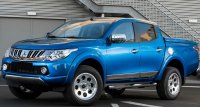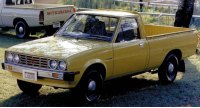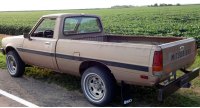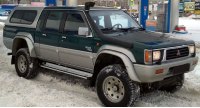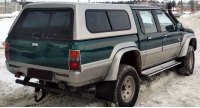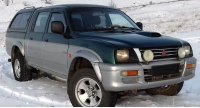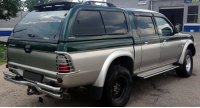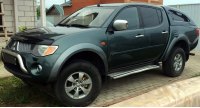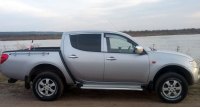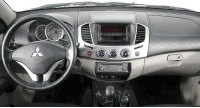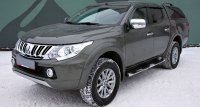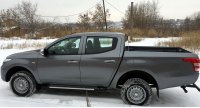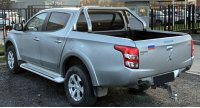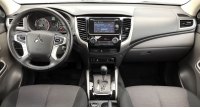Share with friends:
The main classmates and competitors of the Mitsubishi L200 pickup are currently the Chevrolet Colorado, Dodge Dakota, Ford Ranger, Fiat Fullback, Great Wall Wingle, GMC Canyon, Honda Ridgeline, Mazda BT-50, Nissan Navara, Nissan NP300, Suzuki Equator, SsangYong Actyon Sport, Toyota Hilux, Toyota Tacoma, UAZ Patriot Pickup and Volkswagen Amarok.
First generation (1978-1986)
The first generation of a pickup truck appeared in 1978 in Japan under the name «Forte». The body was only two-door with two places for people in the cab. The length of the car was 4690 mm, width 1650 mm and height 1560-1645 mm. Other brand name «Mitsubishi» were «L200», «L200 Express», «L200 Power X», «Mighty Max», under other brand names were «Chrysler D-50», «Chrysler L200 Express», «Dodge D-50», «Dodge Ram 50» And «Plymouth Arrow Truck». Assembly was carried out only in Japan. The engine was located longitudinally in front, rear-wheel drive or four-wheel drive, which appeared in 1981. The entire structure and body are assembled on a supporting steel frame. In 1979, in the USA, the car received an award «Pickup of the year».
Gasoline engines were all 1.6 liter four-cylinder in-line (1597 cm3, 4G32/G32B, 91 hp), 2.0 liters (1995 cm3, 4G52, 93 hp), 2.0 liters (1997 cm3, 4G63/G63B, 108 hp) and 2.6 liters (2555 cm3, 4G54, 105 hp). There were two models of diesel engines, also four-cylinders with a volume of 2.3 liters (2346 cm3, 4D55, 67 hp) and 2.5 liters (2476 cm3, 4D56, 73 hp). Gearbox four- or five-speed manual.
Disc brakes were installed on the front wheels, a spring front suspension, a leaf spring rear suspension with shock absorbers installed on them. The all-wheel drive system included an additional lever located next to the main gear shifter. When shifting, the car moves at half speed for any given engine speed.
Second generation (1986-1996)
In 1986, the second generation of the pickup truck was introduced. In addition to the two-door body (length 4501 mm, width 1655 mm, height 1486 mm) four-door model appeared (length 4920 mm, width 1655 mm, height 1506 mm). The curb weight was 1220-1635 mm. In Japan, pickups have not been sold for several years, so they returned under the name «Strada» in March 1991. In Australia, the car was called «Triton», in Thailand «Cyclone», in South Africa «Colt», as well as the names were «L200» And «Mighty Max». Company «Chrysler» sold this pickup called «Dodge Ram 50», and in 1987 his successor appeared «Dodge Dakota».
There were three 2.0-liter petrol four-cylinder engines (1997 cm3, 4G63/G63B, 92 hp), 2.4 liters (2351 cm3, 4G64, 145 hp) and 2.6 liters (2555 cm3, 4G54, 131 hp), as well as one 3.0-liter V-shaped six-cylinder (2972 cm3, 6G72, 141 hp). There were two models of diesel engines, both with a volume of 2.5 liters (2476 cm3, 4D56), atmospheric power 74 hp and turbocharged with 84 hp. Gearbox four-speed automatic or five-speed manual.
In 1993, the car was updated, which brought a new grille and new plastic bumpers.
Third generation (1996-2006)
In 1996, the third generation was introduced with a two-door pickup truck (length 5125 mm, width 1775 mm, height 1800 mm), four-door pickup truck (length 5010 mm, width 1775 mm, height 1800 mm) and a five-door station wagon. The curb weight of the car was 1380-1795 kg. The names in different countries were also different. An SUV was created on the basis of the L200 «Mitsubishi Challenger», which was also called «Montero Sport», «Pajero Sport», «Shogun Sport» or «Nativa». It has many of the same components and some body parts (e.g. front doors) with a pickup truck and uses a wheelbase «Pajero» second generation.
There were two 2.0-liter petrol four-cylinder engines (1997 cm3, 4G63, 95 hp) and 2.4 liters (2351 cm3, 4G64, 145 hp), as well as one six-cylinder V-shaped volume of 3.0 liters (2972 cm3, 6G72, 141 hp). Diesel four-cylinder engines had four options with a volume of 2.5 liters (2477 cm3, 4D56/4D56T, naturally aspirated 100 HP, turbocharged 136 hp) and 2.8 liters (2835 cm3, 4M40/4M40T, naturally aspirated 80 HP, turbocharged 123 hp). Gearbox four-speed automatic or five-speed manual.
At the end of 2001, the car underwent a facelift with new headlights and other minor changes.
Fourth generation (2005-2014)
The fourth generation was released in 2005. Production was mainly carried out in Thailand by a subsidiary «Mitsubishi Motors (Thailand)» and from there the car was exported all over the world. The most common name has been «Mitsubishi L200», but there were also others, such as «Triton», «Strada», «Sportero», «Hunter» And «Strakar». The body was a two-door pickup (length 5115 mm, width 1750 mm, height 1775 mm) and four-door pickup (length 5000 mm, width 1800 mm, height 1780 mm). The curb weight was 1880-1935 kg.
There were two models of gasoline engines, one four-cylinder 2.4-liter (2351 cm3, 4G64, 132 hp) and one six-cylinder 3.5 liters (3497 cm3, 6G74, 186 hp). Diesel engines are also two models, both four-cylinder turbocharged 2.5-liter (2477 cm3, 4D56, 136 hp) and 3.2 liters (3200 cm3, 4M41, 162 hp). The transmission is a five-speed manual or a four- and five-speed automatic.
Fifth generation (2015-present)
At the beginning of 2015, the fifth generation Mitsubishi L200 with a two-door pickup truck or a four-door pickup truck began to be exported to some countries. The length of the car is 5210 mm, width 1820 mm, height 1780 mm and curb weight 1915 kg. Production is still only in Thailand. In addition to the main name «L200» were also «Triton», «Ram 1200», «Strada», «Strakar», «Barbarian», as well as for Europe and the Middle East produced «Fiat Fullback».
The gasoline engine was installed only one four-cylinder 2.4-liter (2351 cm3, 4G64, 140 hp). Diesel engines two models, four-cylinder turbocharged 2.4-liter (2442 cm3, 4N15, MIVEC, 154 hp) and 2.5 liters (2476 cm3, 4D56, 175 hp). Gearboxes are five- or six-speed manual or automatic.
In the spring of 2018, the updated L200 2019 model year was shown at the Bangkok International Motor Show in Thailand. The front of the car has changed quite a lot, the rear lights have been changed and minor changes in the interior.

